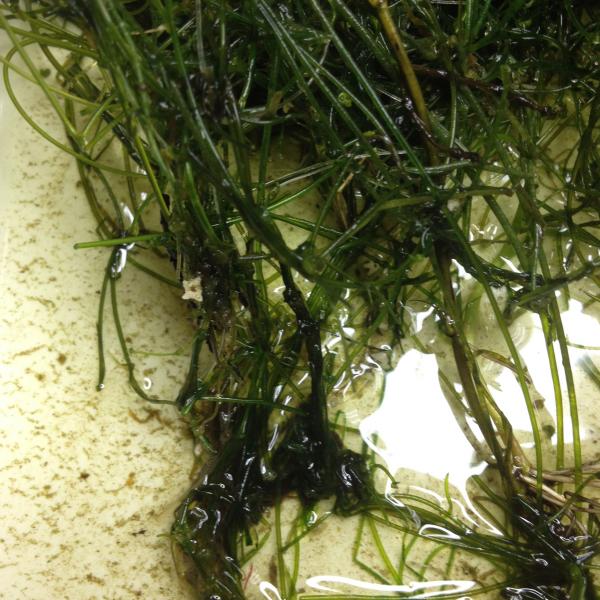
News Source
Department of Environmental Conservation (DEC) staff recently confirmed the presence of starry stonewort(Nitellopsis obtusa) in a small cove on the southeast side of Lake Memphremagog in Newport. This non-native, invasive can develop large, dense stands, crowd out other aquatic plants, and can tolerate low- or high-nutrient conditions. Although it looks like a plant, it is technically classified as a macroalgae, an early ancestor of plants.
It was first observed in the cove by trained Vermont Invasive Patroller (VIP) Valerie Dillon, who brought it to the attention of DEC staff in late June during a VIP practice survey on Lake Memphremagog. A sample was collected at that time, but it did not have the specific, mature features needed to positively identify it. DEC staff returned in late August to collect additional samples, which allowed them to confirm its identity.
The Lake Memphremagog population is the first confirmed population of starry stonewort in a Vermont water body. Thought to be a native of Europe and western Asia, it was first reported in the St. Lawrence River in 1978 and is now found in inland lakes in many states including Massachusetts, Michigan, Indiana, and New York. The Lake Memphremagog find is the first confirmation of an aquatic invasive “plant” new to the state since variable-leaved watermilfoil (Myriophyllum heterophyllum) was found in 2008 in Halls Lake in Newbury.
This new invasive species find highlights the important role volunteers play in keeping a watchful eye on their local water bodies. Through the VIP program, volunteers are trained to identify the aquatic invasive species that pose the greatest threat to Vermont lakes, to survey their favorite lake or pond (or section thereof) once or twice a summer, and to submit their surveys and any suspicious findings to DEC staff. VIP workshops are offered in June and early July, and staff-led practice surveys, in July, August, and September. Dillon mentioned that her participation in the VIP program inspired her to look a little more closely at the places she frequently paddles – we’re grateful she did.
Staff will continue to determine the extent of the infestation and review management options for starry stonewort at this site. Remember, practicing and promoting Clean, Drain, and Dry (including a high pressure, hot water wash if available) will help prevent the transport of this and other aquatic invasive species.
A bit of silver lining to this invasive species find - during their return visit to the cove in August, DEC staff also observed great pond snails (Lymnaea stagnalis). These snails have only been collected three times in Vermont and are listed as a species of special concern. They can grow up to 7 cm, can live for several years, and have lungs, which allow them to be seen on the surface – how they were observed that day. They also prefer stagnant, slow moving water, such as that found in the cove. Although it’s difficult to be certain, their presence may indicate one species that can tolerate this newly discovered, unwelcome macroalgae.
For more information, contact Ann Bove.